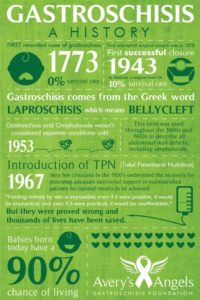GASTROSCHISIS
Gastroschisis is a birth defect that causes the intestines to protrude from a hole in the abdomen, typically to the right of the umbilical cord. Occasionally, other organs are involved as well. This must be repaired surgically after birth, although surgery is not always possible immediately and depends on many factors including the amount of bowel outside of the body. While approximately 90% of affected infants survive in industrialized nations with proper medical care, there is still a 10% mortality rate due to complications or related defects and infections – even with the best medical care. [In the USA, published survival rates range from 83%-97%1]In nations without access to proper medical care, the mortality rate is often 100%.
In the United States, Gastroschisis affects 1 out of every 2229 babies according to the CDC2, although the actual rate varies by state. California, for example, published a 2005 report which showed the incidence to be 1 in 1727 births3 and Texas rates show the incidence to be 1 in 1683 in 20094. In Canada, the current rate is 1 in 2272 with an exception of the area of Nunavut, which for unknown reasons is as high as 1 in 510 births5. Worldwide, rates of gastroschisis in industrial nations vary between 1 in 2000 and 1 in 33336, although some regions have higher rates, such as Wales which is reported at 1 in 16127 births and an area in Australia with an incidence as high as 1 in 8928. According to the International Clearinghouse for Birth Defects Surveillance and Research, a 2009 report from 16 separate registries shows that South America as a whole has the highest reported incidences of gastroschisis in the world, at 1 in 1063 births4. It is worth noting that there is little to no data collected on incidences in Africa.
Rates of gastroschisis are increasing worldwide, and this trend is being called a “pandemic” by many researchers9. The medical community still does not know what causes gastroschisis, but researchers have found many correlations and risk factors including aspirin and other medication use10, exposure to certain chemicals, low maternal body mass index, and genitourinary infections11. Studies from Utah are demonstrating a familial link to gastroschisis, with one study showing that 23% of families studied had more than one relative with gastroschisis12. However, the single largest risk factor for having a child with gastroschisis continues to be young maternal age. The CDC continues to monitor these trends in the US13. Additionally, a 2006 study from the UK showed that mothers under 20 years old have an incidence of gastroschisis ranging from 1 in 1123 to 1 in 40914.
Although the overall prognosis is good for most infants born with this birth defect provided they have access to medical care, complications do arise. Studies show that gastroschisis is the leading cause of intestinal transplantation15, and that 40% of gastroschisis survivors will need to be readmitted to the hospital at some point due to complications, the most common of which are bowel obstruction and abdominal pain16. Furthermore, having a child with a birth defect can put many stressors on a family that others simply do not experience, and it is recommended that families have a strong support network17.
Avery’s Angels Gastroschisis Foundation is the only nonprofit in the United States to assist and support those affected by gastroschisis. When we first formed, Avery’s Angels was the only nonprofit in the world with this cause; now we are joined by the Luey Jacob Sharp Foundation18 in the United Kingdom. To learn about how Avery’s Angels was founded, please click HERE.
Avery’s Angels Gastroschisis Foundation’s mission is to promote awareness, research, and support for gastroschisis worldwide. We accomplish this by:
– Creating a national and international network of families dealing with gastroschisis and related complications.
– Providing emotional and financial support to families who have or are expecting babies born with gastroschisis.
– Supporting friends and families of survivors of gastroschisis and those who have lost a loved one to this disease.
– Promoting national awareness annually via Gastroschisis Awareness Day events every year on July 30th.
– Collaborating with clinicians to facilitate research to find the cause.
– Assisting in other ways as indicated by the circumstances.
AAGF is an all-volunteer foundation. There are no paid employees. We depend on your donations and volunteers to accomplish this vital mission. Please encourage family and friends to “Get Involved.” To learn more about how you can help visit the Volunteer page.
Citations:
- http://www.medscape.com/viewarticle/458475_14
- http://www.cdc.gov/ncbddd/birthdefects/features/birthdefects-keyfindings.html
- http://www.cdph.ca.gov/programs/CBDMP/Documents/MO-CBDMP-Gastroschisis.pdf
- http://www.icbdsr.org/filebank/documents/ar2005/Report2011.pdf
- http://www.aphp.ca/pdf/CAC%20report%202013%20EN.pdf
- http://www.ncbi.nlm.nih.gov/pmc/articles/PMC2432124/
- http://webarchive.nationalarchives.gov.uk/+/www.dh.gov.uk/en/Publicationsandstatistics/Publications/AnnualReports/Browsable/DH_5328840
- http://www0.health.nsw.gov.au/resources/whatsnew/pdf/gastroschisis_report.pdf
- http://onlinelibrary.wiley.com/doi/10.1002/ajmg.c.30181/abstract
- http://onlinelibrary.wiley.com/doi/10.1002/(SICI)1096-9926(199606)54:2%3C84::AID-TERA4%3E3.0.CO;2-4/abstract
- http://www.ncbi.nlm.nih.gov/pmc/articles/PMC2432124/
- http://www.ncbi.nlm.nih.gov/pubmed/21987464
- http://www.cdc.gov/ncbddd/birthdefects/features/gastroschisis-key-findings.html
- http://www.ncbi.nlm.nih.gov/pmc/articles/PMC1360382/
- http://www.ncbi.nlm.nih.gov/pubmed/17101355
- http://www.ncbi.nlm.nih.gov/pubmed/21311496?dopt=Abstract
- http://www.ncbi.nlm.nih.gov/pmc/articles/PMC3774449
- http://www.ljsfoundation.org.uk/
Written by Kayte Thomas, MSW, LCSW-A, Medical Liaison. 2010-2015
Video credits: Haley Jensby

